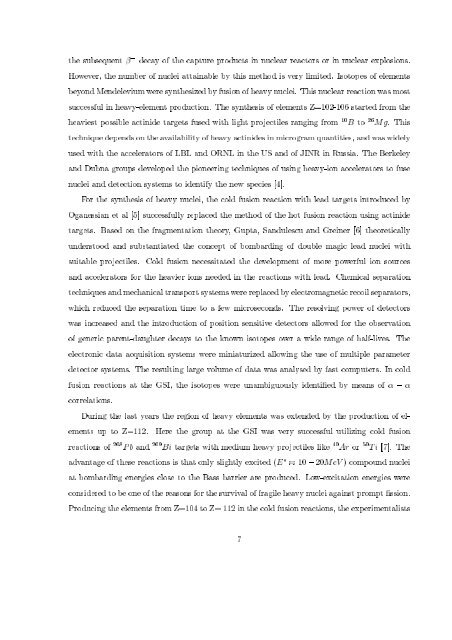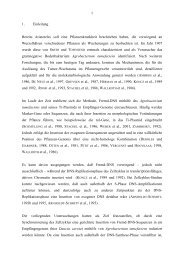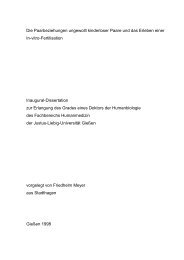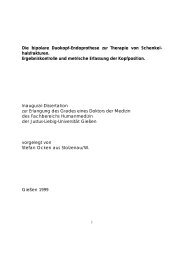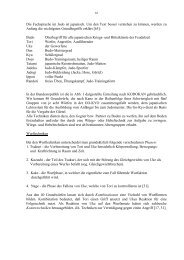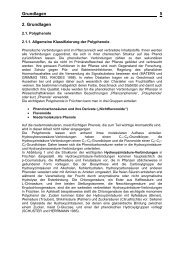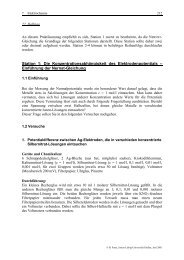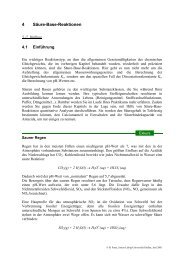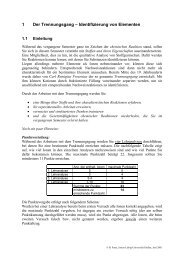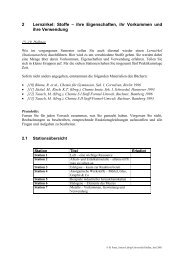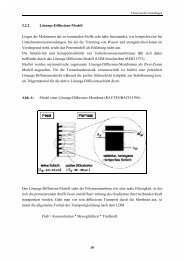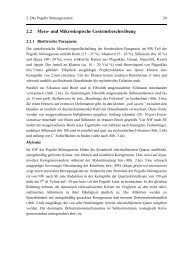Effects of diabaticity on fusion of heavy nuclei in the dinuclear model ...
Effects of diabaticity on fusion of heavy nuclei in the dinuclear model ...
Effects of diabaticity on fusion of heavy nuclei in the dinuclear model ...
You also want an ePaper? Increase the reach of your titles
YUMPU automatically turns print PDFs into web optimized ePapers that Google loves.
<strong>the</strong> subsequent β − decay <str<strong>on</strong>g>of</str<strong>on</strong>g> <strong>the</strong> capture products <strong>in</strong> nuclear reactors or <strong>in</strong> nuclear explosi<strong>on</strong>s.<br />
However, <strong>the</strong> number <str<strong>on</strong>g>of</str<strong>on</strong>g> <strong>nuclei</strong> atta<strong>in</strong>able by this method is very limited. Isotopes <str<strong>on</strong>g>of</str<strong>on</strong>g> elements<br />
bey<strong>on</strong>d Mendelevium were syn<strong>the</strong>sized by fusi<strong>on</strong> <str<strong>on</strong>g>of</str<strong>on</strong>g> <strong>heavy</strong> <strong>nuclei</strong>. This nuclear reacti<strong>on</strong> was most<br />
successful <strong>in</strong> <strong>heavy</strong>-element producti<strong>on</strong>. The syn<strong>the</strong>sis <str<strong>on</strong>g>of</str<strong>on</strong>g> elements Z=102-106 started from <strong>the</strong><br />
heaviest possible act<strong>in</strong>ide targets fused with light projectiles rang<strong>in</strong>g from 10 B to 26 Mg.This<br />
technique depends <strong>on</strong> <strong>the</strong> availability <str<strong>on</strong>g>of</str<strong>on</strong>g> <strong>heavy</strong> act<strong>in</strong>ides <strong>in</strong> microgram quantities, and was widely<br />
used with <strong>the</strong> accelerators <str<strong>on</strong>g>of</str<strong>on</strong>g> LBL and ORNL <strong>in</strong> <strong>the</strong> US and <str<strong>on</strong>g>of</str<strong>on</strong>g> JINR <strong>in</strong> Russia. The Berkeley<br />
and Dubna groups developed <strong>the</strong> pi<strong>on</strong>eer<strong>in</strong>g techniques <str<strong>on</strong>g>of</str<strong>on</strong>g> us<strong>in</strong>g <strong>heavy</strong>-i<strong>on</strong> accelerators to fuse<br />
<strong>nuclei</strong> and detecti<strong>on</strong> systems to identify <strong>the</strong> new species [4].<br />
For <strong>the</strong> syn<strong>the</strong>sis <str<strong>on</strong>g>of</str<strong>on</strong>g> <strong>heavy</strong> <strong>nuclei</strong>, <strong>the</strong> cold fusi<strong>on</strong> reacti<strong>on</strong> with lead targets <strong>in</strong>troduced by<br />
Oganessian et al [5] successfully replaced <strong>the</strong> method <str<strong>on</strong>g>of</str<strong>on</strong>g> <strong>the</strong> hot fusi<strong>on</strong> reacti<strong>on</strong> us<strong>in</strong>g act<strong>in</strong>ide<br />
targets. Based <strong>on</strong> <strong>the</strong> fragmentati<strong>on</strong> <strong>the</strong>ory, Gupta, Sandulescu and Gre<strong>in</strong>er [6] <strong>the</strong>oretically<br />
understood and substantiated <strong>the</strong> c<strong>on</strong>cept <str<strong>on</strong>g>of</str<strong>on</strong>g> bombard<strong>in</strong>g <str<strong>on</strong>g>of</str<strong>on</strong>g> double magic lead <strong>nuclei</strong> with<br />
suitable projectiles. Cold fusi<strong>on</strong> necessitated <strong>the</strong> development <str<strong>on</strong>g>of</str<strong>on</strong>g> more powerful i<strong>on</strong> sources<br />
and accelerators for <strong>the</strong> heavier i<strong>on</strong>s needed <strong>in</strong> <strong>the</strong> reacti<strong>on</strong>s with lead. Chemical separati<strong>on</strong><br />
techniques and mechanical transport systems were replaced by electromagnetic recoil separators,<br />
which reduced <strong>the</strong> separati<strong>on</strong> time to a few microsec<strong>on</strong>ds. The resolv<strong>in</strong>g power <str<strong>on</strong>g>of</str<strong>on</strong>g> detectors<br />
was <strong>in</strong>creased and <strong>the</strong> <strong>in</strong>troducti<strong>on</strong> <str<strong>on</strong>g>of</str<strong>on</strong>g> positi<strong>on</strong> sensitive detectors allowed for <strong>the</strong> observati<strong>on</strong><br />
<str<strong>on</strong>g>of</str<strong>on</strong>g> generic parent-daughter decays to <strong>the</strong> known isotopes over a wide range <str<strong>on</strong>g>of</str<strong>on</strong>g> half-lives. The<br />
electr<strong>on</strong>ic data acquisiti<strong>on</strong> systems were m<strong>in</strong>iaturized allow<strong>in</strong>g <strong>the</strong> use <str<strong>on</strong>g>of</str<strong>on</strong>g> multiple parameter<br />
detector systems. The result<strong>in</strong>g large volume <str<strong>on</strong>g>of</str<strong>on</strong>g> data was analysed by fast computers. In cold<br />
fusi<strong>on</strong> reacti<strong>on</strong>s at <strong>the</strong> GSI, <strong>the</strong> isotopes were unambiguously identified by means <str<strong>on</strong>g>of</str<strong>on</strong>g> α − α<br />
correlati<strong>on</strong>s.<br />
Dur<strong>in</strong>g <strong>the</strong> last years <strong>the</strong> regi<strong>on</strong> <str<strong>on</strong>g>of</str<strong>on</strong>g> <strong>heavy</strong> elements was extended by <strong>the</strong> producti<strong>on</strong> <str<strong>on</strong>g>of</str<strong>on</strong>g> el-<br />
ements up to Z=112. Here <strong>the</strong> group at <strong>the</strong> GSI was very successful utiliz<strong>in</strong>g cold fusi<strong>on</strong><br />
reacti<strong>on</strong>s <str<strong>on</strong>g>of</str<strong>on</strong>g> 208 Pb and 209 Bi targets with medium <strong>heavy</strong> projectiles like 40 Ar or 50 Ti [7]. The<br />
advantage <str<strong>on</strong>g>of</str<strong>on</strong>g> <strong>the</strong>se reacti<strong>on</strong>s is that <strong>on</strong>ly slightly excited (E ∗ ≈ 10 − 20MeV) compound <strong>nuclei</strong><br />
at bombard<strong>in</strong>g energies close to <strong>the</strong> Bass barrier are produced. Low-excitati<strong>on</strong> energies were<br />
c<strong>on</strong>sidered to be <strong>on</strong>e <str<strong>on</strong>g>of</str<strong>on</strong>g> <strong>the</strong> reas<strong>on</strong>s for <strong>the</strong> survival <str<strong>on</strong>g>of</str<strong>on</strong>g> fragile <strong>heavy</strong> <strong>nuclei</strong> aga<strong>in</strong>st prompt fissi<strong>on</strong>.<br />
Produc<strong>in</strong>g <strong>the</strong> elements from Z=104 to Z= 112 <strong>in</strong> <strong>the</strong> cold fusi<strong>on</strong> reacti<strong>on</strong>s, <strong>the</strong> experimentalists<br />
7


